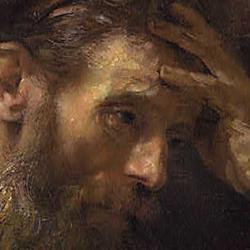According to Robert Kolb (Martin Luther: Confessor of the Faith, 125–8) Luther had a “relational” understanding of righteousness: “Whereas most medieval thinkers conceived of human ‘righteousness’ in terms of performance or activity, Luther believed that the concept rested on a deeper foundation. Righteousness is being what the person or thing is supposed to be. That identity issues naturally into action. . . . Relationship, for Luther, constituted a vital part of reality because God, as the first and fundamental reality, is a person. The reality of God as he has revealed himself to humanity cannot be defined apart from his disposition toward and interaction with human beings; the reality of humanity cannot be defined apart from the creature’s reliance upon the Creator. Faithfulness to each other define both God and the human creature.”
Justification is on this understanding a restoration of right relationship, which Luther describes as a new creation accomplished by God’s declaration of righteousness: “This word-act that restores sinners to righteousness accomplishes its task through the mystery of God’s becoming human in Jesus, his dying to satisfy the law’s demand for the sinner’s death, and his rising from death to give new life to his people. That new life begins with the fundamental orientation of human life, trusting in God, a trust that accepts the gift of identity as child of God and hearkens to God’s will for an obedient life of good works.”
He speaks of “imputation,” but this does not in any way suggest legal fiction. For Luther, God’s “imputing fashioned actuality.” Sin remained, yet “the fact of God’s gift of righteousness through his regard and his Word constituted the dominant truth of the sinner’s state. . . . he depicted justification as the verdict of the judge who determines guilt or innocence by what he says. When highlighting the fundamental reality of what God has accomplished, he employed the language of re-creation, of death and new life.”
Thus justification was death and resurrection: “From early on, Luther spoke of God’s killing and making alive as he described justification, for he presumed that sinners must die (Rom. 6: 23a) and be resurrected to life in Christ.” By the same token, justification is “also an act of new creation. In a doctoral promotion disputation of 1535 on faith and law, composed in the midst of papal initiatives for a general council, at which Luther wanted justification to be a topic, he wrote: ‘justification is in reality a kind of rebirth in newness’ ( John 1: 12–13; 1 John 5: 1), ‘a washing of regeneration and renewal’ (Titus 3: 5), new birth (John 3: 3); the Holy Spirit calls God’s people ‘righteous, a new creature of God and the first fruits of God’s creatures, who, according to his will brought us forth by his Word (2 Cor. 5: 17; Jas. 1: 18).’”
Kolb thinks that recent Lutheran attempts to get “beyond” forensic understandings of justification “are both historically inaccurate and theologically unnecessary . . . [because] the more ‘forensic’ Luther’s teaching becomes, the more ‘effective’ it is, because nothing can be more real than that which God’s Word declares.”












